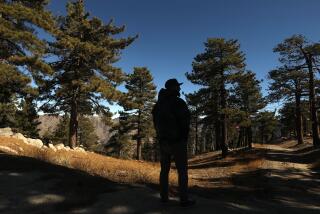Off-Roaders Accept Plan to Limit Desert Access
- Share via
Off-road vehicle riders clearly feel they have already lost too much of their recreational land, but about 75 at a public hearing Thursday night appeared to have grudgingly accepted a proposal to allow the Navy to restrict public access to 48,500 acres in the Imperial County desert.
The hearing was called by the federal Bureau of Land Management, which has for several months been negotiating with the Navy over control of more than 300,000 acres of prime off-road riding land in the desert. Under an agreement struck by the Navy and the BLM, the Navy would also be given the right-of-way to an additional 66,500 acres, although that land would remain open under yet-to-be-negotiated conditions for desert recreation.
“We’re counting on the BLM to keep up its tough negotiating stance,” said Al Kolster of the state Parks and Recreation Department off-highway vehicle division. “These people are concerned because we (the state) ask them to pay registration fees ($35 annually per vehicle, earmarked for development of off-road vehicle parks), but they’re left with fewer and fewer places to ride.”
The once-smoldering controversy over the plan to close parts of the Imperial County desert for flight training exercises was largely defused when the Navy and the BLM announced a compromise at a crowded public hearing in San Bernardino last month.
The Navy, which already controls more than 600,000 acres in the Imperial County desert, had proposed that it be given jurisdiction over an additional 315,000 acres, much of which lies in the prime playground for thousands of off-road vehicle enthusiasts in Southern California. The Navy wanted the land to ensure that its training exercises could be conducted without endangering the public.
The 48,500-acre tract now proposed for Navy control is used by off-roaders but is adjacent to six bombing ranges used by fliers stationed at the Navy base at El Centro.
Off-road vehicle riders had feared for the future of their sport--the only state park for off-roaders in San Diego County is at Ocotillo Wells, next to the land originally sought by the Navy. (Saddleback Park, the only such park in Orange County, was recently closed for construction of housing.)
Closure of the surrounding area would have exacerbated the already-crowded conditions at Ocotillo Wells, where, according to estimates by state rangers, as many as 10,000 off-roaders ride and camp on a busy weekend.
Navy officials had promised to keep favored off-road areas open if they did not conflict with training maneuvers, but Gerald Hillyear, district manager for the BLM, was skeptical about that arrangement.
“Despite the Navy’s assurances, its promise could not have been binding once it was given control of the land,” Hillyear said. “It could have blocked off any portions of that land whenever it wanted to. That’s exactly what the Navy has done with all of the land it controls in California. We didn’t want to be in the position of giving up that much prime recreational space.”
Mark Harms, of Valley Center, said too much land has been lost already. “First it’s some kind of a plant, then it’s a lizard, then it’s the Navy bombing,” Harms said. “For one reason or another, we keep losing our land. I think it’s time we stopped it, now. The Navy doesn’t need to take any more land.”
Subsequent public hearings on the agreement will be held in Los Angeles and somewhere in western Arizona. The proposal will also be subjected to an environmental impact review because it involves an amendment to the California Desert Plan and must, if the land is to be deeded to the Navy for more than 20 years, as the current arrangement dictates, receive congressional approval.
Hillyear said it would likely take a year for the approval process to be completed. “There might be some slight modifications during that time,” he said, “but I think we have something we all can live with.”
More to Read
Sign up for Essential California
The most important California stories and recommendations in your inbox every morning.
You may occasionally receive promotional content from the Los Angeles Times.










